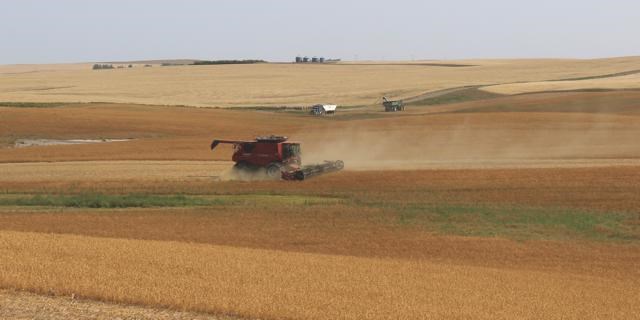Despite rain delays in some areas, producers in the province now have seven per cent of the crop in the bin and seven per cent swathed or ready to straight-cut, reported Saskatchewan Agriculture for the week ending August 14.
This figure is ahead of the five-year average for this time of year which is four per cent combined and six per cent swathed or ready to straight-cut and the 10-year average of four per cent of all crops combined in the province. One year ago, three per cent of the crop was in the bin and seven per cent was swathed or ready to straight-cut. At that time, many fields had excess moisture and they were unable to support the weight of harvesting equipment. Reported yields last year were average to above-average for most crops. Two years ago, nine per cent of all crops had been combined across the province.
Harvest progress is most advanced in the southwest region where 17 per cent of the crop is now combined. The southeast region has 11 per cent combined, the west-central region three percent and the east-central region one per cent. Many producers in the north expect to be in the field in the coming weeks, although desiccation and swathing has begun in some areas.
Each crop is at a different stage of harvesting. Across the province, winter wheat is 50 per cent combined, six per cent in swath, 21 per cent ready to combine and 23 per cent standing. In total across the province, producers have 77 per cent of the fall rye combined, five percent in silage or greenfeed, four per cent in swath, nine per cent ready to straight combine and five per cent standing.
Canaryseed, flax, canola, soybeans and chickpeas have not yet been combined. Although, six per cent of canola is in swath. Mustard is mostly standing at, 90 per cent standing, five per cent in swath, two per cent ready to straight combine, and two per cent has been combined. Field peas are 28 per cent combined, 57 per cent standing, one per cent in swath and 14 per cent ready to straight combine. Lentils are about 35 per cent combined, 47 per cent standing, one per cent in swath and 17 per cent ready to straight combine.
The cereals harvest across the province is behind other crops. Spring wheat is one per cent combined, 97 per cent standing and two per cent ready to straight combine. Durum is only three per cent combined, five per cent ready to straight combine and 92 per cent standing. Barley is two per cent combined with one per cent in greenfeed or silage, three per cent in swath, two per cent ready to straight combine and 92 per cent standing. Oats is one per cent combined, one per cent in swath and 98 per cent standing.
Topsoil moisture continues to improve for many areas with the recent rain. Across the province, topsoil moisture on cropland is rated as one per cent surplus, 42 per cent adequate, 38 per cent short and 19 per cent very short. Hay land and pasture topsoil moisture is rated as one per cent surplus, 32 per cent adequate, 35 per cent short and 32 per cent very short.
Rainfall in the first week of August ranged from trace amounts to 48 mm in the Turtleford area. While the rain has been welcomed in some areas to help crops fill, it is too late to be of benefit in more southern areas where crops are rapidly drying down or have already been combined.
The majority of crop damage this reporting week is attributed to hail, localized flooding, lack of moisture and insects such as diamondback moths in canola. Producers are busy combining, desiccating crops and hauling bales and grain.
In southwestern Saskatchewan, the harvest operations continue to rapidly advance in the area. Producers now have 17 per cent of the crop in the bin and 11 per cent swathed or ready to straight-cut, well ahead of the five-year average for this time of year of eight per cent combined and nine per cent swathed or ready to straight-cut. The Coronach, Assiniboia and Ogema crop district has six per cent of the crop in the bin, the Gravelbourg, Mossbank, Mortlach and Central Butte crop district has 14 per cent, the Kyle, Swift Current, Shaunavon and Ponteix crop district has between 12 per cent to 24 per cent, and the Consul, Maple Creek and Leader crop district has 26 per cent swathed and 16 per cent combined.
In the southwest, winter wheat is 12 per cent standing, 35 per cent ready to combine and 53 per cent combined. Fall rye is one per cent standing, two per cent in swath, two per cent ready to straight combine, 89 per cent combined, and 6 per cent in greenfeed or silage. Spring wheat is not swathed and is only one per cent combined with 95 per cent standing, and four per cent ready to straight combine. Durum is 92 per cent standing, six per cent ready to straight combine, and two per cent combined. Barley is 90 per cent standing, four per cent ready to straight combine, four per cent combined and two per cent in greenfeed or silage. Oats is 87 per cent standing, eight per cent in swath, and five per cent combined.




